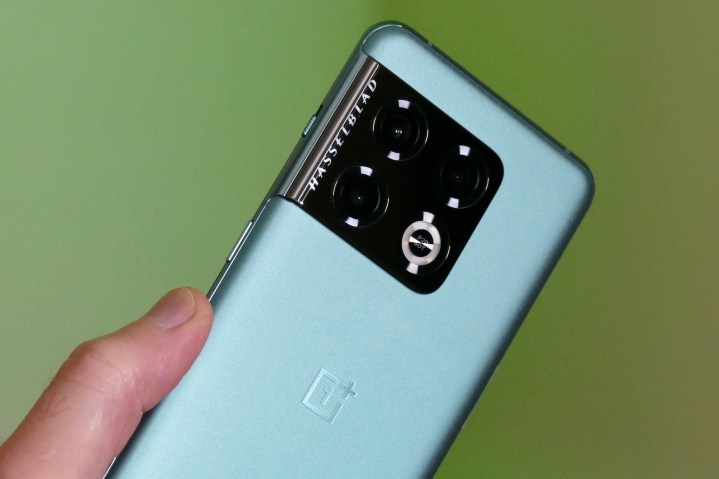The OnePlus 10T is an oddly positioned smartphone, to say the least. It contradicts OnePlus’ recent stride toward premium offerings with devices such as the OnePlus 9 Pro and the OnePlus 10 Pro. Instead, it appears to shoulder the same “never settle” spirit that OnePlus was once famous for, being geared toward users who demand unbeatable performance but who can compromise on the cosmetic or camera fronts.
While the OnePlus 10T offers top-of-the-line specifications, the 10T also accommodates some compromises for a more reasonable price. These shortcomings deflect it to the class of flagship killers, below the true flagships, which recent OnePlus numeric series phones have tended toward. All these changes stir up a sense that the company is trying to break through the image it has created in the last few years, especially since its readmission into camp Oppo.
To understand how the OnePlus 10T differs from other flagship OnePlus phones in the recent past, it is valuable to study the metamorphosis of the company’s T-series upgrades.
OnePlus evoluTion

The first T upgrade from OnePlus came in the form of the OnePlus 3T. The letter symbolically referred to a more souped-up, Turbo version, even though OnePlus simply wanted it to be seen as a step ahead of Apple’s customary S-upgrades. The OnePlus 3T offered marginal internal upgrades, including the option for larger internal storage and a slightly improved chipset.
The leap from the third to the fifth generation — after skipping over the fourth one due to Chinese traditions — witnessed a different form of T upgrade. The OnePlus 5T featured internals identical to the OnePlus 5 but with a taller display. The 6T also took a similar approach as OnePlus opted for a taller display with an in-screen fingerprint sensor — a first for the company.

The OnePlus 7 series was a turning point for OnePlus, which by then had gotten ready to enter the flagship segment in 2019 with the OnePlus 7 Pro. The OnePlus 7T, which came late that year, nested between the OnePlus 7 and the OnePlus 7 Pro. Unlike the older upgrades, however, it was completely overhauled and offered many new features over the non-Pro-non-T variant.
The following year, OnePlus followed a similar tradition by focusing on the performance of the OnePlus 8T after promoting the OnePlus 8 and the 8 Pro as its candidates for the premium segment. The flat display panels and the simpler camera module gave the OnePlus 8T a rather crude — and what some might label as a less premium — design, but with over two times faster charging than the OnePlus 8 and the 8 Pro. This slotted the OnePlus 8T easily between the two models.

By this design, the OnePlus 9T would secure a position between the OnePlus 9 and the OnePlus 9 Pro. But the whole dynamic changed in the company, with one of the co-founders moving out and the other leading it back into Oppo, which had birthed OnePlus in 2014. At the same time, it diversified into the mid-range segment with the Nord series and branched further into fitness wearables, including a OnePlus Band and a OnePlus Watch. Prioritizing this brand restructuring, OnePlus decided to drop the OnePlus 9T from its roadmap for 2021.
Now in 2022, OnePlus opted for yet another recourse, launching the OnePlus 10 Pro without a non-Pro variant. Therefore, even though the OnePlus 10T fills the gap created by the lack of a 9T, it ends up being the OnePlus 10 that never was — and the phone that hardly anyone wants because of its reduced improvements.
The OnePlus 10 that never was
The OnePlus 10 Pro set a high bar for performance, but more importantly, its aesthetics and camera performance. Its vapor cooling mechanism persevered against the excessive warmth produced by the Snapdragon 8 Gen 1 chipset. OnePlus also took the challenge to create an elegant ceramic profile around the camera.
The outline is crafted by sintering the ceramic part at 1,400 degrees Celsius over four days and then brushing it for another 60 hours to polish the surface for a mirror-like finish that stealthily blends into the aluminum frame. Kinder Liu, the chief operating officer at OnePlus, previously told us the company made significant “breakthroughs” while creating a “burdenless design” for the OnePlus 10 Pro.

The shoes, unfortunately, are too big for the OnePlus 10T to fill. Although it may be a stretch to expect the OnePlus 10T to match up to the 10 Pro’s good looks and refined display, the 10T also fares far below in camera performance due to a primary sensor smaller than even a two-year-old OnePlus 8 Pro, plus baseless auxiliary cameras such as the 2MP macro one.
It does make up for this with its more efficient Snapdragon 8+ Gen 1 chipset and a much faster 150-watt (125-watt in North America) charging, but it’s not enough to stop the phone from feeling out of place.
A price gap too small
For many who have wholeheartedly accepted OnePlus in its new and more diverse avatar, the OnePlus 10T might appear not only oddly placed, but also inconsistent with its primary lineup. For those who still wish OnePlus hadn’t settled, the 10T goes with the former image of OnePlus, but not serendipitously. That’s because of its high price, which is closer to the pricing of the OnePlus 10 Pro than the OnePlus One’s introductory pricing.

The price difference between the two phones makes the decision to choose the OnePlus 10T over the 10 Pro a hard one. The OnePlus 10T starts at $649, while you can get the OnePlus 10 Pro by paying $799. The Pro’s higher pricing is justified by better cameras, a more enduring and meticulous design, a far superior display, and a slightly bigger battery.
The OnePlus 10T signifies a return to the company’s older form but not the same glory, remaining a major step down from the 10 Pro. That’s what ultimately makes the OnePlus 10T lackluster and somewhat Terrible … despite its Turbo specifications.



